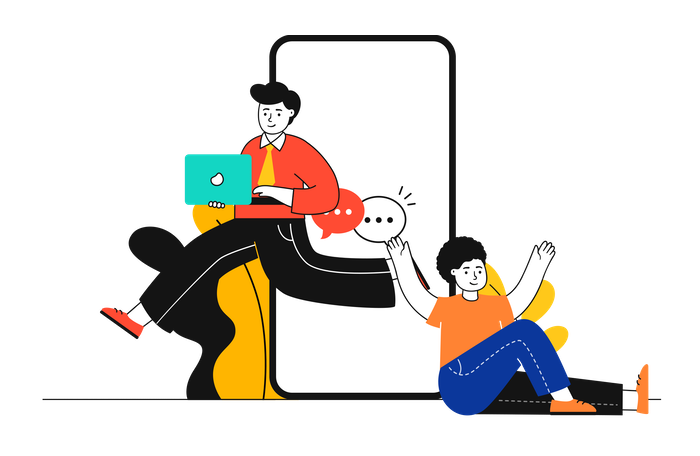Interview with Mehdi Mazeas, Armatis’ Digital Project Manager.
Your career so far in a few words
I’m currently Digital Project Manager in Armatis’ Digital Data Division.
I’ve been with the Group for 19 years now, with several highpoints in my career.
I started out as a sales representative in the telecommunications sector and went on to spend 10 years as a proximity manager.
During that time, I also launched 2 companies specialising in computer services, with the status of salaried entrepreneur.
In 2012, I was promoted to Business Coordinator, with the mission of staging operations and coming up with motivation scenarios. It was in this context that I created SODA (link to SODA article) as an intraprenarial initiative within the Group.
And in 2017, I became the Group’s first Digital Project Manager!
We hear a lot about digitisation and hybridisation of working methods. What does that mean in practice today?
For me, hybridisation of working methods means the determination to find a point of balance between integration of innovative components, digitised solutions, and employees’ experience in order to create virtuous behaviours and, ultimately, services that have a positive impact on end customers.
It’s a mixture of traditional customer experience practices and innovative digital, organisational and managerial solutions with a view to obtaining enhanced behaviours on the part of our employees and consequent improvement of the customer experience.
Hybridisation doesn’t only impact working methods, it also affects employees’ relationship with their work.
So norms must be reversed by involving them in joint development of the tools they need in order to be yet better at what they do.
To this end, it’s important to make a detailed study of signals of low employee expectations, as aspirations at work have evolved significantly over recent years, in particular among younger generations of employees.
Hybridisation is the reflection of a sociology of work that’s changing and now revolves around a pressing need for autonomy, access to knowledge, interaction and responsiveness.
In short, hybridisation is an underlying trend that we try to include in all forms of organisation and which aims to develop the potentials and quality of employee experience at all levels (operationally, socially and personally). The advantage of having an employee’s point of view is that it leads to operational efficiency, development of the relationship with work and self-actualisation.

How do you set about designing a hybrid solution?
These days, there’s a mainstream trend that seeks to bring ever increasing numbers of tools and innovations to the milestones on the employee journey in symmetry with the customer journey.
Nonetheless, it must be clearly understood that an innovation offer does not automatically create demand.
Achieving balance, which is the aim in hybridisation choices, means always ensuring more of the human touch! The departure point is still the user, the employee, and they must be the central concern.
Organisations that wish to innovate and provide hybrid journeys must be able to listen to their employees’ voices and analyse weak signals so as to be able to model the best approaches.
The purpose here is not to turn employees into passive users, but into ambassadors.
Then, this initial fan base, these promotors of proximity, will do away with any doubts their colleagues might have through social proof, by transmitting knowledge and impactful behaviours and showing the way to the most unwilling employees, even though we know that there are always a few users who come over with time.
At the end of the day, a hybrid customer relations solution requires joint development with employees over the medium term rather than a pyramid system. There’s no such thing as hybridisation, organisational transformation, over the short term, it’s an iterative journey.
An example?
The first one’s SODA, a digital social solution thought up and designed by its users in 2015, on the principles of gamification. It deals with such concrete issues as remote collaboration / socialisation, making best use of talents, engagement and, consequently, performance.
The project was the result of analysis and identification of weak signals in the 2015 social barometer, in items to do with motivation and internal communication methods.
The solution now has over 2,200 users. Its success is based on observation of and listening to employees, user-orientated joint development, and assistance with getting to grips with it on our sites in order to communicate best practices and do away with any lingering doubts.
Current user satisfaction stands at 95%.
The second example is the “Link Me Up” digital workplace, rolled out during the 2020 lockdown.
The departure point for this project, which took a “design thinking” approach, was the Armatis employee’s persona in that context (loss of colleagues, loss of referents, new work environment, stress caused by the situation, uncertainties, and so on).
We asked ourselves what our colleagues might need in this period of isolation and mass telework. Such as getting back into a reassuring setting, social ties, simple interactions, and information.
As a result, we created a team-sized digital private room, with interactive messaging, files, procedures, and so on.
We launched Version 1 in April and had 2,500 users for 150 brands in May.
Is the ultimate goal an augmented advisor?
The ultimate goal isn’t to produce augmented advisors, but rather repositioned advisors, i.e. centred on the customer experience, on customer relations.
As far as I’m concerned, the goal of hybridisation of working methods in our activities is to come up with advisors ready and able to focus on the quality of differentiating, unrivalled customer relations.
When all’s said and done, the central issue with hybridisation is you always need more of the human touch.
And then? What’s the future of customer service from an employee’s point of view?
Ideally, our employees will have 2 roles:
They’ll be the leading contributors to knowledge transfer and enrichment of artificial intelligence.
Bots, callbots, chatbots, digital voices (…) will require emotional intelligence if they are to be relevant and more effective.
But emotional intelligence can’t be programmed and you can’t buy an experience update.
So you need expert advisors who’ve accumulated a solid basis of knowledge over the course of their careers, in order to transcribe and calibrate it, make updates, train models and ensure that bots are ever more refined, relevant and generators of customer experience.
Their second role will be as high added-value experts on very specialised procedures that will require analyses, complex arbitration and transversality.
In my opinion, we’re arriving at a new customer relations paradigm: relations where technologies that simulate interactions, autonomy, instantaneousness, go side-by-side with dedicated advisors on high added-value cases.
Advisors, customers, all of us are still social beings in need of meaningful interactions, stories to share.
As I see it, that’s the balance point that hybridisation has to achieve: providing technological backup that fosters the most virtuous behaviours without ever overlooking the need for social interaction and stories to share.
Because when you look at a pathway, whether it’s a professional career or a life path, in the end you only remember stories and words that you’ve had a personal stake in. That’s the challenge of hybridising customer relations!



